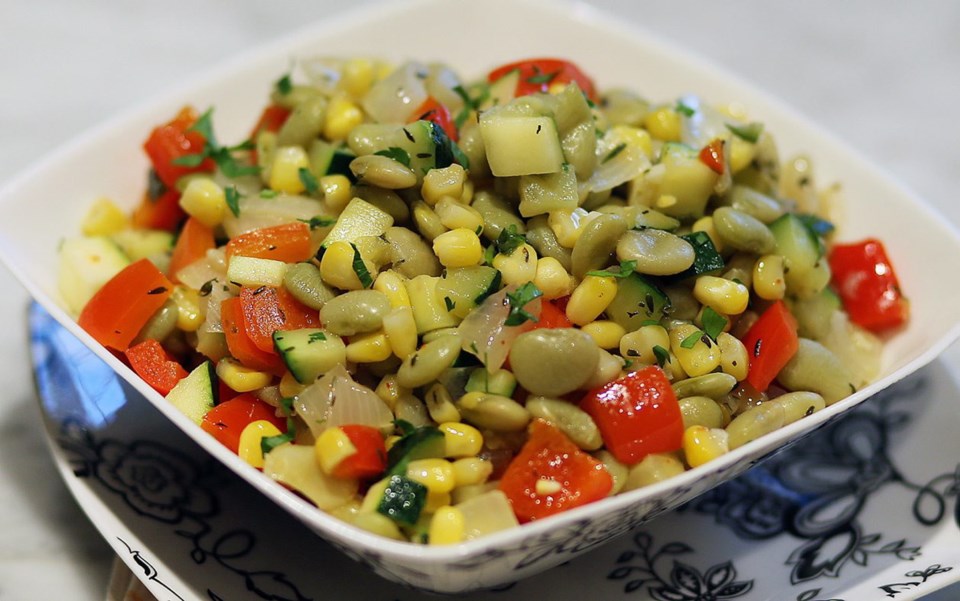Dear Eric: Could you give me a recipe for succotash? Also, where can I find those wonderful Fordhook lima beans, frozen or fresh?
Jackie Gibbs
Dear Jackie: When I was a kid, I loved watching Looney Tunes cartoons and still have catchphrases from those shows in my head. Sylvester the cat uttered one of them: “Sufferin’ succotash!”
Back then, I didn't know what succotash was, but I knew Syl-vester used that line when things weren’t going well. I also didn’t know, until researching this article, that the catchphrase wasn’t written specifically for that cartoon.
“Sufferin’ succotash” is Great Depression-era minced oath; a gentle way of saying something considered profane. It was more socially acceptable than saying “suffering saviour,” which I take to mean: “Can things get worse?”
According to information found on the Princeton University website, princeton.edu, the word and subsequent dish known as succotash was derived from the First Nations Narragansett language term, “msíckquatash,” which means boiled corn kernels.
Succotash originally consisted primarily of corn and lima beans or other shell beans. Over time, other ingredients were added, such as bell peppers, zucchini and other vegetables. Regional variations of succotash also developed. For example, in the southern U.S., any mixture of vegetables prepared with lima beans and dollops of butter or lard is called succotash.
Because succotash could be made from readily available, budget-friendly ingredients, it became a popular and sustaining meal to serve during the Great Depression. The Princeton University website notes that sometimes it was cooked in a casserole form, often with crust, creating a type of pot pie minus the meat.
These days succotash is still enjoyed in New England and other areas on the Eastern Seaboard, where it is sometimes part of the Thanksgiving feast.
Fordhooks are a variety of lima beans, the edible seed of a legume. Several sources describe it as the finest, plumpest and most buttery-tasting lima bean around.
Unfortunately, I could not find a source of them locally, but have seen them for sale south of the border — not surprising given the popularity of succotash.
All I could find locally was canned, dried and frozen lima beans generically labelled “lima beans.” The reason the Fordhook variety is unavailable here must be due to market demand. We don’t eat as many lima beans here as they do in other parts of North America.
However, an Internet search of Fordhook beans produces numerous seed companies selling seeds to grow your own Fordhook lima beans.
So, Jackie, if you really like them, plant some next year and time them to be ready for picking when local corn is in season.
Succotash
You could serve this colourful version of succotash as a vegetarian main course spooned over rice. Or, serve it as a side dish for a roast, baked ham, fish or anything else a mix of vegetables and lima beans would pair well with.
Preparation time: 20 minutes
Cooking time: About 15 minutes
Makes: 4 to 6 servings
2 Tbsp butter
1 Tbsp olive oil
1/2 medium onion, diced
1 large garlic clove, minced
1 medium zucchini, cut into small 1/4-inch cubes
1 medium red bell pepper, cut into small 1/4-inch cubes
1 (14 oz./398 mL) can lima beans, drained, rinsed in cold water, and drained again (see Note)
1 1/2 cups fresh or frozen corn kernels
• salt and freshly ground black pepper to taste
1/2 tsp dried sage leaves (see Note)
1/4 tsp dried thyme
• pinch each cayenne and paprika
2 Tbsp chopped parsley
Place butter and oil in a fairly wide pot or deep skillet (mine was 10 inches wide) set over medium to medium-high heat.
Add onion and garlic and cook until softened, about five minutes. Add the remaining ingredients, except parsley. Partially cover and cook, stirring occasionally, until the vegetables are tender, about 10 minutes. Stir in the parsley and enjoy.
Note: If you wanted to use frozen, thawed, lima beans in this recipe, replace the canned lima beans with 1 1/2 cups of frozen beans.
Note: Dried sage leaves are available in the bottled herb aisle of most supermarkets. It’s made from crumbled sage leaves; don’t mistake it for finely ground sage.
Eric Akis is the author of the hardcover book Everyone Can Cook Everything. His columns appear in the Life section Wednesday and Sunday. Submit questions by email.
